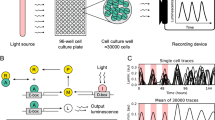Abstract
Based on experimental work on the ontogeny of the electroretinogram circadian rhythm in crayfish, we present a mathematical model simulating changes in both frequency and amplitude of the electroretinogram oscillation during several developmental stages until shortly before the adult age. Simultaneously, we propose a hypothetical oscillation in the hormonal release whose frequency is imposed on the electroretinogram oscillation. The model consists of two coupled nonlinear oscillators in which a dynamical response is obtained mainly through an Andronov-Hopf bifurcation. Through the construction of the model, a biological hypothesis about the essential elements underlying the ERG circadian rhythm and their interrelations is formulated and discussed.
Similar content being viewed by others
Literature
Abramowitz, A. A. 1937. The chromatophorotropic hormone of the crustacea: standarization, properties and physiology of the eye-stalk glands.Biol. Bull. 72, 344–365.
Arnold, V. I. 1983.Geometrical Methods in the Theory of Ordinary Differential Equations. Grundlehren der mathematischen Wissenschaften 250, 334 pp. Berlin: Springer-Verlag.
Cartwright, M. L. 1948. Forced oscillations in nearly sinusoidal systems.J. Inst. Elect. Engrs III 95, 88–96.
Daan, S. and C. Berde. 1978. Two coupled oscillators: Simulations of the circadian pacemaker in mammalian activity rhythms.J. theor. Biol. 70, 297–313.
Fanjul-Moles, M. L., E. Moreno-Sáenz, N. Villalobos-Hiriart and B. Fuentes-Pardo. 1987. ERG circadian rhythm in the course of ontogeny in crayfish.Comp. Biochem. Physiol. 88A, 213–219.
Fuentes-Pardo, B., J. Hernández-Falcón and J. Noguerón and I. Noguerón. 1984. Effect of external level of calcium upon the photoreceptor potential of crayfish along the twenty-four hour cycle.Comp. Biochem. Physiol. 78A, 723–727.
Fuentes-Pardo, B. and V. Inclán-Rubio. 1987. Caudal photoreceptors synchronize the circadian rhythms in crayfish I. Synchronization of ERG and locomotor circadian rhythms.Comp. Biochem. Physiol. 86A, 523–527.
Fuentes-Pardo, B., M. L. Fanjul-Moles and E. Moreno-Sáenz. 1992. Synchronization by light of the ERG circadian rhythm during ontogeny of the crayfish.J. Interdisc. Cycle Res., in press.
Gorgels-Kallen, J. L. and C. E. M. Voorter. 1985. The secretory dynamics of the CHH-producing cell group in the eyestalk of the crayfish,Astacus leptodactylus, in the course of the day/night cycle.Cell Tissue Res. 241, 361–366.
Hafner, G. S., T. Tokarski and G. Hammond-Soltis. 1982. Development of the crayfish retina: A light and electron microscopic study.J. Morphol. 173, 101–118.
Hernández-Falcón, J., E. Moreno-Sáenz, J. M. Farías and B. Fuentes-Pardo. 1987. Role of the sinus gland on crayfish circadian rhythmicity. I. Pseudopupil circadian rhythm.Comp. Biochem. Physiol. 87A, 111–118.
Johnsson, A. and H. G. Karlsson. 1972. A feedback model for biological rhythms. I. Mathematical description and basic properties of the model.J. theor. Biol. 36, 153–174.
Kalmus, H. and L. A. Wigglesworth. 1960. Shock excited systems as models for biological rhythms.Cold Spring Harbor Symp. Quant. Biol. 25, 211–216.
Kawato, M. 1981. Transient and steady state phase response curves of limit cycles oscillators.J. math. Biol. 12, 13–30.
Kawato, M. and R. Suzuki. 1980. Two coupled neural oscillators as model of the circadian pacemaker.J. theor. Biol. 86, 547–575.
Kleinholz, L. H. 1934. Eye-stalk hormone and the movement of distal retinal pigment inPalaemonetes.Proc. natn. Acad. Sci. 20, 659–661.
Kopell, N. 1983. Forced and coupled oscillators in biological applications.Proceedings of the International Congress of Mathematicians, Warszawa, pp. 16–24.
Lewis, R. D. and D. S. Saunders. 1987. A damped circadian oscillator model for an insect photoperiodic clock. I. Description of the model based on a feedback control system.J. theor. Biol. 128, 47–59.
Moreno, A. P. 1988. Modulación humoral de las uniones comunicantes. Ph. D. Thesis, CINVESTAV, IPN, México.
Moreno-Sáenz, E., J. Hernández-Falcón and B. Fuentes-Pardo. 1987. Role of the sinus gland on crayfish circadian rhythmicity. II. ERG circadian rhythm.Comp. Biochem. Physiol. 87A, 119–125.
Moreno-Sáenz, E., B. Fuentes-Pardo and J. Hernández-Falcón. (1992). Photoentrainment of the ERG circadian rhythm in crayfish and its dependence on the sinus gland.
Naka, K. and M. Kuwabara. 1959. Two components from the compound eye of the crayfish.J. exp. Biol. 36, 51–61.
Pavlidis, T. 1968. A mathematical model for the temperature effects on circadian rhythms.J. theor. Biol. 18, 210–221.
Pavlidis, T. 1973.Biological Oscillators: Their Mathematical Analysis. New York: Academic Press.
Peterson, E. L. 1980. A limit cycle interpretation of a mosquito circadian oscillator.J. theor. Biol. 84, 281–310.
Rand, R. H. and P. J. Holmes. 1980. Bifurcation of periodic motions in two weakly coupled van der Pol oscillators.J. Non-Linear Mech. 15, 387–399.
Sánchez, J. A. and B. Fuentes-Pardo. 1977. Circadian rhythm in the amplitude of the electroretinogram in the isolated eyestalk of the crayfish.Comp. Biochem. Physiol. 56A, 601–605.
Shishkova, M. A. 1973. Study of one system of differential equations with small parameter at higher derivative.Dokl. Acad. Sci. U.S.S.R. 209, 576–579.
Smith, R. 1948. The role of the sinus gland in retinal pigment migration in grapsoid crabs.Biol. Bull. 75, 169–185.
Strogatz, S. H. 1978. Human sleep and circadian rhythms: a simple model based on two coupled oscillators.J. math. Biol. 25, 327–347.
von Bertalanffy, L. 1968.General System Theory, Development, Applications. New York: G. Brazillier.
Welsh, J. H. 1939. The action of the eye-stalk extracts on retinal pigment migration in the crayfishCambarus bartoni.Biol. Bull. 77, 119–125.
Winfree, A. T. 1967. Biological rhythms and the behavior of populations of coupled oscillators.J. theor. Biol. 16, 15–42.
Winfree, A. T. 1980.The Geometry of Biological Time. Berlin: Springer-Verlag.
Author information
Authors and Affiliations
Rights and permissions
About this article
Cite this article
Lara-Aparicio, M., de Medrano, S.L., Fuentes-Pardo, B. et al. A qualitative mathematical model of the ontogeny of a circadian rhythm in crayfish. Bltn Mathcal Biology 55, 97–110 (1993). https://doi.org/10.1007/BF02460296
Received:
Revised:
Issue Date:
DOI: https://doi.org/10.1007/BF02460296




